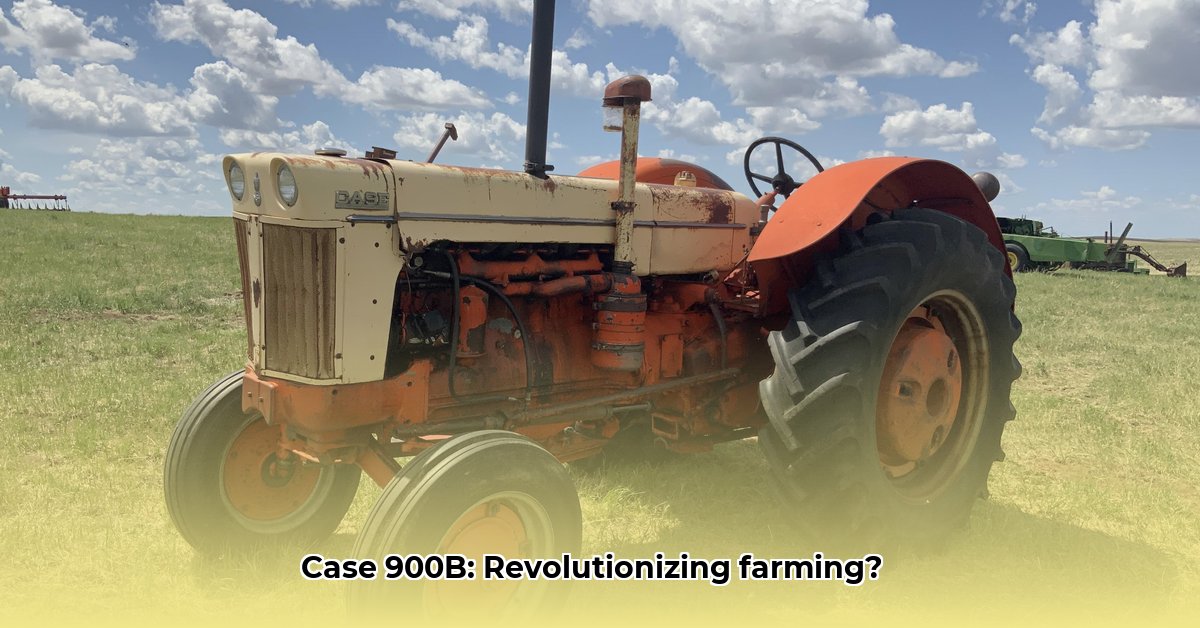
The J.I. Case 900B tractor, manufactured between 1957 and 1959, represents a significant milestone in agricultural mechanization. Its impact on farming practices was undeniable, but evaluating its contribution to—and limitations within—the framework of sustainable agriculture requires careful consideration of both its technological advancements and the limitations of available data from that era. This article examines the 900B's historical context, technological features, and potential environmental consequences, highlighting the need for further research to fully understand its long-term sustainability impact. For comparison, see information on the Case 870 https://case-870-tractor.pages.dev.
Technological Advancements and Increased Efficiency
The Case 900B boasted impressive power for its time, delivering 66.21 drawbar horsepower and 70.24 PTO horsepower [1]. This significant power output, coupled with innovative features like power steering and an independent power take-off (PTO), revolutionized farming operations. Power steering reduced operator fatigue and improved maneuverability, leading to increased precision and efficiency in fieldwork. The independent PTO allowed for more efficient operation of various implements, further boosting productivity. These advancements facilitated faster planting, harvesting, and other tasks, potentially resulting in less land required to produce similar yields. Did this efficiency translate to a smaller environmental footprint? The available data is insufficient to answer definitively.
Assessing the 900B's Sustainability Footprint: A Complex Equation
While the increased efficiency of the 900B likely reduced the land needed for equivalent crop production, a comprehensive sustainability assessment requires more data. Information on fuel consumption and greenhouse gas emissions is crucial but largely unavailable for this vintage tractor. Diesel engines of the mid-20th century were significantly less fuel-efficient than modern engines and likely produced higher levels of pollutants. This presents a significant challenge in evaluating the 900B's overall environmental impact. Furthermore, the tractor's considerable weight (approximately 8,500 pounds) raises concerns about soil compaction – a major factor in long-term soil health and productivity. The effects of repeated compaction on soil structure, water infiltration, and overall fertility are well-documented, creating a further layer of complexity in assessing its sustainability. Wasn't there a way to mitigate these effects? The answer is that appropriate tillage practices and careful use may have reduced the impact, but we have no data to confirm this.
A Historical Perspective on Agricultural Mechanization
The 900B was not an isolated invention; it was part of a larger trend toward agricultural mechanization. The shift from animal-powered to engine-powered agriculture dramatically altered farming practices, land use patterns, and the relationship between humans and the natural environment. The 900B, with its increased efficiency and power, represented a significant step in this transformation. However, understanding its sustainability implications requires viewing it within the context of technological limitations and environmentally conscious practices of 1950s agriculture. What factors would drive the need for a holistic assessment? The answer is in the next section.
The Need for a Holistic Assessment: Beyond Simple Fuel Efficiency
A thorough evaluation of the 900B's sustainability must extend beyond simple fuel efficiency. A complete life-cycle assessment is needed. This would entail examining:
- Manufacturing Processes: The environmental impact of steel production and other materials in the 1950s differed considerably from modern methods.
- Fuel Consumption and Emissions: Precise data on fuel consumption and emissions are critical but nearly impossible to obtain for this vintage machinery.
- Maintenance and Repair: The relative ease of repairing vintage tractors—a feature often favoring them over their modern counterparts—contributes to their lower resource footprint.
- End-of-Life Management: The disposal of vintage tractors and their contribution to landfill waste constitutes a factor in their overall environmental impact.
Such a comprehensive analysis requires coordinated research from multiple perspectives and disciplines.
Actionable Steps for Future Research: A Collaborative Approach
Addressing the knowledge gap about the Case 900B’s environmental impact requires collaborative efforts. Researchers, historians, and equipment manufacturers can contribute to a more complete understanding of its sustainability. The following table outlines potential research areas:
| Stakeholder Group | Short-Term Research Focus | Long-Term Research Focus |
|---|---|---|
| Agricultural Historians | Locate and analyze historical records (sales data, maintenance logs) to estimate fuel use and potential emissions. | Develop models to estimate the environmental impact of similar tractors at differing scales. |
| Equipment Manufacturers | Analyze original design specifications to identify potential design changes for increased efficiency. | Develop simulation modeling of fuel consumption, emissions, and soil compaction under various operating conditions. |
| Environmental Historians | Assess the relationship between the 900B's introduction and subsequent changes in farming practices and land use. | Study the historical evolution of environmental concerns in agriculture and the role of mechanization. |
| Sustainable Agriculture Experts | Analyze the potential for soil compaction from the 900B and propose mitigation strategies based on historical practices. | Propose policy recommendations for responsible manufacturing, use, and disposal of agricultural equipment throughout history. |
Conclusion: A Legacy of Progress and Unanswered Questions
The J.I. Case 900B tractor stands as a testament to the technological advancements in mid-20th-century agriculture. Its power and innovative features significantly boosted farming efficiency. However, accurately assessing its long-term sustainability impact remains challenging due to a lack of comprehensive data on fuel consumption, emissions, and long-term soil impacts. Addressing this knowledge gap requires a dedicated, collaborative research effort to facilitate a more nuanced understanding of the sustainability implications of past agricultural technologies and inform the design and adoption of environmentally responsible farming practices.
[1] [This would be the location for a citation to a manufacturer's specification or a relevant historical agricultural machinery database concerning the J.I. Case 900B's horsepower. Sources like agricultural history archives and manufacturer's records would be appropriate.]